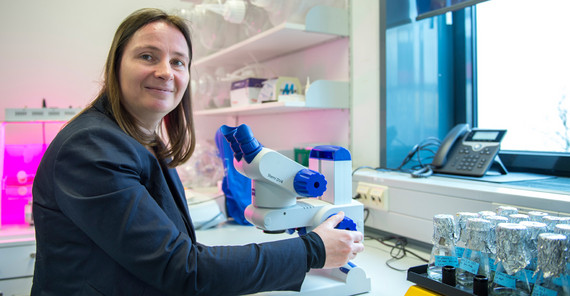It could have all turned out differently. Looking back, Prof. Dr. Elke Dittmann attributes her success in becoming Professor of Microbiology at the Institute of Biochemistry and Biology at the University of Potsdam in 2009 to a stroke of good fortune. At the time, the institute was looking for someone specializing in green microorganisms and photosynthetic or symbiotic bacteria to fit with its profile. And she fit the bill! Dittmann has since gotten settled in Potsdam. Collaborating with colleagues from other areas of expertise has been a common thread throughout her professional career. And this has helped advance her, as she says, step by step. The planned cluster in the joint federal and state Excellence Strategy would be another step.
Elke Dittmann’s laboratory is functional, everything in its right place: a desk, instruments for experiments, a cultivation unit at the back of the room. The room is tailor-made for doing microbiology and molecular biology. The shelves to the right hold flasks of colored liquids, mostly deep green: freshwater cyanobacteria floating in water, which come, for instance, from Lake Zernsee – near the Institute – or from bacteria strain collections. “Here we primarily study the role of toxins that can be produced by cyanobacteria. We are also looking for new agents applicable for pharmaceuticals and to develop them further,” Dittmann explains. Some flasks contain brown, terrestrial cyanobacteria, which exist in the upper layers of the soil and contain additional pigments. The biologist uses them to study the role of secondary metabolic products – or metabolites – in symbiosis with other plants.
Cyanobacteria – often erroneous called blue-green algae in everyday speech – are known for their ability to perform oxygenic photosynthesis. Dittmann’s research focuses on them, and she has studied them in many places throughout her career: Berlin, Sydney, Wuhan (China), Johannesburg, and, of course, many times in the Potsdam laboratory. Bacteria are important organisms in our planet’s material cycles. Without them, Earth could not host life. These microorganisms have existed for over 2.5 billion years, utilizing carbon dioxide for photosynthesis and producing organic carbon. “Over the long periods of their evolution, they have survived many climate crises with various CO2 concentrations,” the researcher explains. These bacteria are truly survival specialists.
“My research interest fits perfectly into the envisaged excellence cluster, since it focuses on the dynamics of the earth’s surface and examines the interaction between geological, biological, and climate processes,” the biochemist explains. The prospect of collaborating with earth, climate, and environmental scientists inspires her. “It would force me somewhat out of my academic comfort zone,” she says. This would be very exciting, though the first task would be to better understand the methodologies and procedures of other disciplines. To this end, the researcher is looking to participate in the sub-project “Savannah in East Africa” (see Portal, p. 10), in which extensive joint research has been done by geoscientists and biologists. In it, Potsdam researchers have studied how changes in the geosphere are reflected in local climatic deviations and biological developments. “In the new project, I would like to analyze their effects on the cyanobacteria community in East African lakes,” Dittmann says, looking ahead.
Cyanobacteria may indeed play an important role in the cluster. After all, their adaptive mechanisms are so interesting to scientists that considerations are being made to one day send them to Mars. Whether Dittmann will follow them there remains to be seen.
This research is linked to the research initiative NEXUS: Earth Surface Dynamics, which clusters approaches from various scientific disciplines in the Berlin-Brandenburg area within the overarching theme of Earth surface dynamics. The University of Potsdam, along with its partnering institutions the Helmholtz-Centre Potsdam - German Research Centre for Geosciences (GFZ), the Alfred Wegener Institute Helmholtz Centre for Polar and Marine Research (AWI) and partners from the Potsdam Institute for Climate Impact Research (PIK), the Museum für Naturkunde - Leibniz Institute for Evolution and Biodiversity Science (MfN) and the Technische Universität Berlin (TUB) therefore combines the outstanding expertise from geo-, bio-, climate and data sciences.
Text: Petra Görlich
Translation: Monika Wilke
Published online by: Agnetha Lang
Contact for the online editorial office: onlineredaktionuuni-potsdampde

